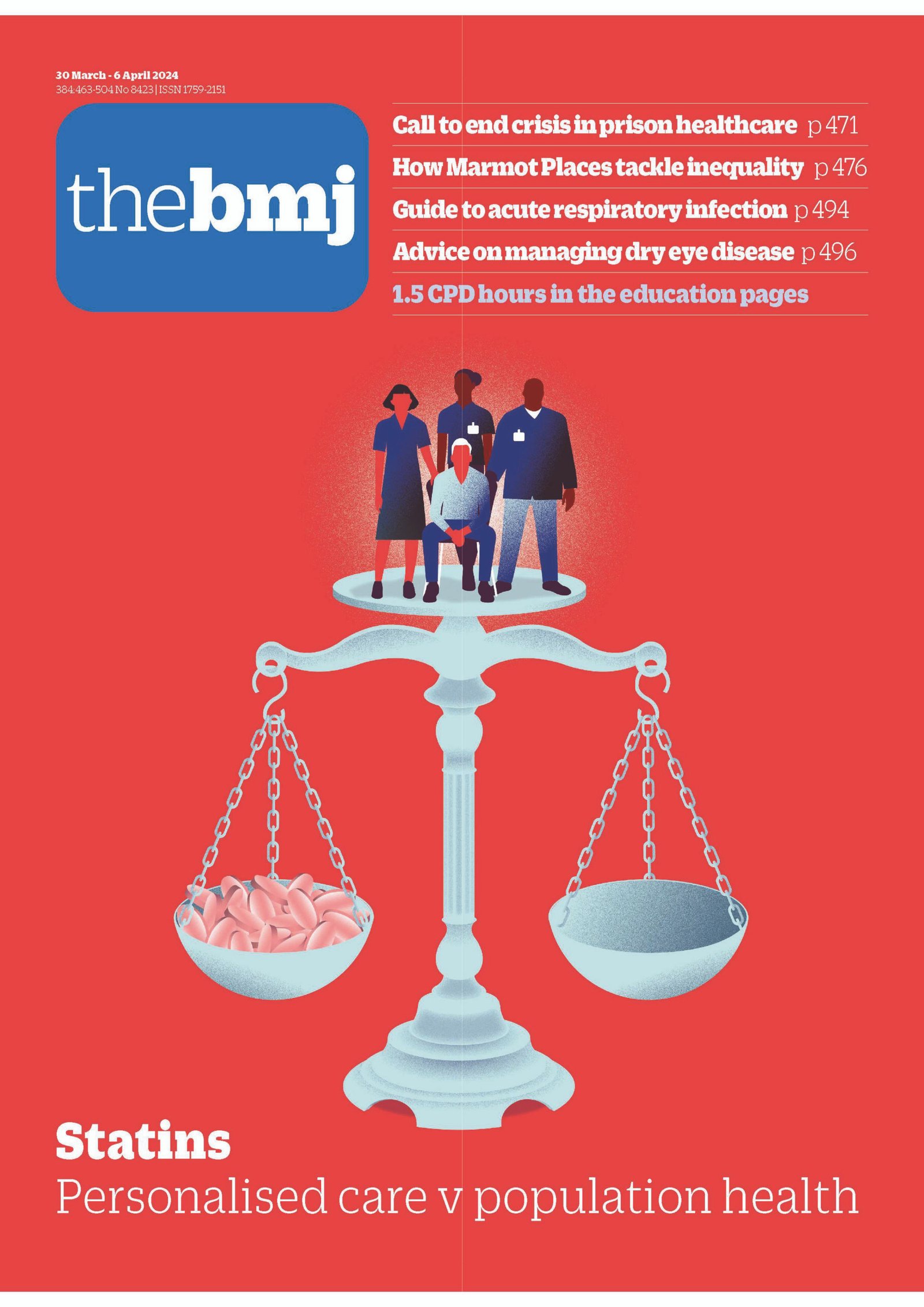- Kevin J Fong, consultant in anaesthesia1 2,
- Charlotte Summers, professor in intensive care medicine3,
- Tim M Cook, professor in intensive care medicine4 5
1University College London Hospitals NHS Trust, London, UK
2Department of Science, Technology, Engineering and Public Policy, University College London, UK
3Victor Phillip Dahdaleh Heart and Lung Research Institute, University of Cambridge, Cambridge, UK
4Royal United Hospitals Foundation Trust, Bath, UK
5School of Medicine, University of Bristol, Bristol, UK
- Correspondence to: K J Fong kevin.fong{at}nhs.net
During the UK’s covid-19 inquiry we have heard that “there was an inbuilt reluctance to accept that it was possible to get to a point where the NHS was overwhelmed” and that NHS capacity was regarded as “elastic.”1 The question of whether the NHS was overwhelmed during the covid-19 pandemic has become an important point of debate. Some commentators continue to suggest that the NHS prepared for a surge in admissions that did not threaten NHS capacity and unnecessarily suspended services.234
These comments either misunderstand or misrepresent the nature of the threat, the NHS response to covid-19, and the concept of capacity in healthcare services. NHS capacity is a complex property of a complex sociotechnical system; it cannot be described through simple numerical counts of bed spaces, occupancy rates, equipment, and staff. In particular, the workforce comprises the social component of this system and capacity cannot be assessed without reference to their experience.

The challenge of planning within this framework is described in shorthand as the four S’s: space, staff, systems, and stuff.5 The NHS entered the pandemic after a long period of substantial financial constraint, resulting in eroded operational resilience. Analysis of the four S’s shows this contributed to many intensive care units (ICUs) in the UK experiencing overwhelming pressure during the pandemic, creating harms for both patients and staff.
Intensive care beds: pre-pandemic resources and staffing
ICUs provide specialist care to patients with immediate life threatening illness or injury leading to single or multiple organ dysfunction. The term “intensive care bed” does not describe an item of furniture but rather a specialised location, a suite of technology, and the specialist staff who use it continuously to try to support and maintain a patient’s life, commonly through lung ventilation, renal replacement, prolonged sedation, and other therapeutic interventions. National standards specify that each mechanically ventilated patient requires one dedicated specialist ICU nurse, while each ICU consultant should care for no more than 12 patients.6
For the past decade, NHS investment has not kept pace with other European countries. The Health Foundation estimates a £40bn shortfall in healthcare funding each year.7 The UK also lags in ICU investment: with 7.3 ICU beds per 100 000 people in 2022, roughly half the average number per capita of many members of the Organisation for Economic Cooperation and Development.8
High levels of ICU bed occupancy and strain are associated with increased hospital mortality.9 The National Audit Office reports that hospitals with average bed occupancy above 85% can expect regular bed shortages and increased numbers of healthcare acquired infections, with bed crises becoming regular above 90% occupancy.10 Occupancy of NHS general and acute beds has climbed steadily since 2011, including from 86% to above 90% between 2016 and 2020.11 English ICU occupancy before the pandemic was 75-88% despite bed numbers increasing. It was in this state of provision that the NHS met the covid-19 pandemic.
Preparing ICUs for the pandemic
The NHS workforce crisis, which predated the pandemic, and limited ICU bed availability made preparations to expand critical care services difficult. On 30 January 2020, the day the World Health Organization declared covid-19 to be a public health emergency of international concern, there were 3654 adult critical care beds in acute hospitals in England, of which 3044 (83%) were occupied.12
Importantly, not all these beds were equipped to provide mechanical ventilation, which the sickest patients with covid-19 would need. Further, not all the beds were staffed, with many ICU posts unfilled,13 further reducing the ability to expand ICU bed capacity.14
Rapid expansion was achieved nevertheless by the end of April 2020—to close to 6000 beds—by creating ad hoc ICU beds in repurposed operating theatres and wards. However, these were far from equivalent to standard ICU provision in terms of skilled staff, equipment, or supporting infrastructure; they met the remit in terms of space but not stuff, staff, or systems. As an example, many used mechanical ventilators designed for use in anaesthesia rather than intensive care. Use of such ventilators for supporting patients with covid-19 was associated with an increased risk of patient harm, including death.15
Hospital staff who did not ordinarily specialise or work in ICU were redeployed to support delivery of ICU care. As patient numbers increased, national guidance changed to permit one ICU nurse to oversee the care of six ventilated patients and one ICU specialist doctor to supervise the care of 60 patients.16
Diluted ratios left staff unable to provide the same specialist care and vigilance that one-to-one nursing affords. Although ICU beds increased to roughly 6000, the newly created capacity was far less capable than standard ICU provision, substantially increasing ICU strain. However, there was no choice but to create this additional capacity as a temporary buffer. During the pandemic, a multicentre observational cohort study of more than 130 000 ICU admissions, across 207 hospitals, found that unprecedented strain on ICU capacity was significantly associated with higher acute hospital mortality.17
The pandemic spread asymmetrically across the country, with infections focused initially in London, then in other densely populated cities, before disseminating across regions. This is crucial to understanding the overwhelming strain that individual ICUs experienced at different times, as the infection rolled across the country. The Nightingale facility in London: a proposed ad hoc field hospital that initially promised a massive expansion in ICU capacity, ultimately proved impossible to staff at scale.18 Elsewhere, Nightingale ICUs either did not open or were repurposed, as it became apparent that the provision of space was not a useful solution in the absence of skilled staff. While pockets of spare ICU capacity did initially exist, accessing these at scale was not practical because of the logistic challenges and clinical risks associated with transferring critically ill patients.19
Surge pressure and risks
While the number of patients in ICU during spring 2020 peaked at 4014,20 seemingly well below the expanded national ICU capacity, these data disguise a more complex picture. Although the UK’s entire expanded ICU capacity was not exceeded during the first surge, the usual and expanded capacity of many units was exhausted at different times.1721 Many hospitals experienced shortages of staff, medicines, equipment, and other essential supplies, including oxygen. In one hospital, oxygen supply problems were so severe that it was forced to declare a major incident and transfer patients to neighbouring hospitals.22
Although much discussion focuses on spring 2020, the wave experienced from December 2020 to February 2021 brought an even larger surge. Official data show an astonishing peak occupancy of 5702 ICU beds in England during this period.20
Even this figure disguises the gravity of the situation. Advanced respiratory therapies such as continuous positive pressure ventilation are—for patient safety—normally delivered in an ICU or other specialised setting. During the pandemic, many thousands of patients received such treatments outside ICU, cared for by medical teams with even more sparse staffing.23 Thus, at the peak of the pandemic, the total number of critically ill patients outstripped ICU capacity.
Transferring critically ill patients between units to ease capacity pressures (capacity transfers) is a substantial logistic challenge, requiring specialist staff and equipment. A multicentre review found that serious adverse events occur in up to 8.9% of critical care transfers.19 Because of this they are avoided wherever possible. But with entire regions operating at the limit of their expanded capacity they became necessary at scale, including over large distances, despite the risk. Since no such transfers are necessary when there is adequate capacity, their number is a marker of system strain. In the winter before the pandemic, from December 2019 to February 2020, only 68 capacity transfers took place, but between December 2020 and February 2021, this increased 30-fold to 2152.24
Covid-19 and surgical backlogs
Providing care in these circumstances was possible only through the extraordinary efforts of staff across the NHS. Redeploying staff to support ICU specialists removed them from their usual specialty roles. Thus, a reduction in non-urgent NHS care was an inevitable consequence of covid-19-related pressure—the greater the covid-19 surge, the greater the need to pause other clinical activity.
Elective operations were initially suspended to enable preparation for the anticipated surge, freeing space for building ad hoc ICUs and training staff in their new roles. As the pandemic progressed, continued redeployment of ward, theatres, and anaesthetic staff; high rates of staff sickness; and the use of operating theatre complexes and surgical wards to accommodate covid-19 patients continued to limit other clinical activity.
The effect of covid-19 surges on anaesthetic and surgical procedures was best illustrated by a survey of UK hospitals in January 2021 by the Royal College of Anaesthetists: 53% reported that covid-19 pressures substantially prevented them from providing anaesthetic services, 38% described anaesthetic care as hampered, and only 9% were able to provide close to normal services.25 The survey specifically questioned which of the four S’s limited capacity, with staffing the predominant factor. More than 2000 anaesthetists were unavailable for theatre work, with 75% redeployed to ICU. Forty two per cent of UK NHS operating theatres were closed, with throughput almost halved in those remaining open. Routine adult non-cancer surgery ran at 33% of pre-pandemic levels, cancer surgery at 61%, and paediatric surgery at 32%. Overall, more than half of surgical activity was lost—close to 10 000 operations every day.25
The strain on ICU persisted well into 2021. Critically ill covid-19 patients often do not develop the need for intensive care until two weeks after infection, after which they may spend many weeks in ICU. It was not until 6 March 2021 that ICU occupancy consistently fell below 4000 in England: still higher than total ICU capacity in early 2020.
Welfare and mental health of ICU staff
Patient facing healthcare workers had, compared with their local population, an up to fourfold increased risk of SARS-CoV-2 infection,26272829 a twofold increased risk of hospital admission,30 and a significantly increased risk of death.31 In one central London hospital, almost half of healthcare workers became infected over a three week period.28
Although our focus is on ICU, the greatest risk of infection, harm, and death was among staff working outside ICU,32 particularly porters, domestic staff, health support workers, and more junior nurses and doctors,2933 and disproportionately affected staff of non-white ethnicity and first generation immigrants.34
Over the course of 2020-21, more than one in three patients with covid-19 admitted to ICU died there35—a much higher death rate than typically experienced even by seasoned ICU workers. Importantly, covid-19 deaths were not restricted to ICU, with many occurring in medical wards and care homes: in the first wave, six of every seven hospital deaths and nine of every 10 deaths overall occurred outside ICU.36
The psychological effect of these experiences on staff was profound. In January 2021, a study of the mental health of staff working in ICU during the pandemic found that almost half of staff reported symptoms consistent with severe depression (52%) and severe anxiety (44%). In addition, 47% of surveyed staff reported symptoms consistent with probable post-traumatic stress disorder, a rate comparable with that seen in British military veterans deployed in combat roles during the Afghanistan war.37 Mental health disorder is known to correlate with impairment in the performance of daily activities, including professional tasks. The survey of ICU staff included responses to the work and social adjustment scale (WSAS) questionnaire, a standardised measure of impairment in functioning. At the peak of the surge of January 2021, 69.1% of staff working in ICU met threshold criteria for moderate (27.9%) or severe (41.2%) functional impairment, further highlighting the hazards—to patients and staff—of operating under conditions of severe strain.
The March 2023 NHS Staff Survey showed that 45% of 636 348 responding staff had felt unwell because of work related stress,38 suggesting an enduring effect on staff wellbeing. The current problems with staff recruitment and retention are unsurprising and well documented.13
Learning from the crisis
Numerical tallies summarising the availability of physical resources—bed spaces and equipment—provide useful data. But without proper consideration and monitoring of the workforce engaged in delivering care, neither capacity nor the danger of it becoming overwhelmed can be estimated properly.
During the covid-19 pandemic the NHS’s usual ICU capacity was substantially exceeded, and this was accompanied by negative effects on patient care and the physical and mental health of NHS staff. The difficult experiences of ICU teams during the pandemic were mirrored by healthcare workers throughout the NHS.
The NHS’s pre-existing workforce crisis and strained bed capacity in the years preceding the pandemic impaired the ability to adapt and respond to the crisis. Nevertheless, the rapid procurement and distribution of equipment, repurposing of existing infrastructure and re-structuring and delivery of care by national, regional, and frontline teams represented an extraordinary achievement—one that we should recognise and learn from. However, the expansion and reshaping of some services was necessarily accompanied by the contraction of others: remodelling rather than elasticity.
Helen McNamara, deputy cabinet secretary in the UK during 2020-21, stated to the UK covid-19 inquiry that she came to understand “what was meant by NHS capacity being elastic was the capacity of people working in the NHS to work themselves into the ground to keep people alive,” and that “in retrospect the conversations were all about the buildings and the beds and not the people that would be need[ed] to staff them.”1
If we wish to learn the lessons from the pandemic and appropriately prepare for future threats, it is essential that we base our analysis of the UK’s response to covid-19 on an accurate account of the pressures experienced and their consequences. The threat from covid-19 for NHS hospitals has receded but not entirely disappeared. Pandemics will inevitably be more frequent in the future, and other NHS crises may also arise.39 We should celebrate our many successes but at the same time must reflect in detail on the areas in which we failed. In particular, we should consider how capacity within healthcare systems is measured, and what mechanisms are required to accurately assess the limits of that capacity so that we minimise the future likelihood of once again breaching the elastic limit of our healthcare staff and system.
Key messages
-
Healthcare system capacity is complex and cannot be described through simple numerical counts of bed spaces, occupancy rates, equipment, and staff
-
Intensive care units (ICUs) in the UK experienced overwhelming pressure during the covid-19 pandemic despite substantial expansion
-
The necessary redeployment of staff to expand ICU capacity prevented continuation of other routine hospital services
-
The healthcare staff who responded faced physical risk and many also experienced psychological harm, exacerbating a pre-existing workforce crisis
-
Future pandemic responses should consider how to accurately assess the limits of healthcare capacity and protect staff wellbeing
Acknowledgments
We thank Michael Toolan, Sarah El-Sheikha, Roopa McCrossan, Kate Kanga, Tristan Caulfield, and Danny Wong for their work in delivering much of the workforce survey data cited in this article, and their ongoing work in the field of NHS workforce wellbeing.
Footnotes
-
Contributors and sources: During the pandemic KJF served as national clinical adviser in emergency preparedness, resilience, and response for the covid-19 incident, CS was involved at local, regional, and national level with the NHS critical care response and along with TMC was an author of guidelines on the covid-19 hub run by the four substantive anaesthesia and intensive care organisations. TMC had a role in research examining both healthcare worker safety and the spread of SARS-CoV-2 infection during medical procedures. All three worked with frontline operational teams and at strategic level during the covid-19 pandemic. All authors contributed to writing the article and approved the final version.
-
Competing interests: We have read and understood BMJ policy on declaration of interests and have the following interests to declare: KJF is currently a Wellcome Trust Innovation and Engagement Fellow and freelance broadcaster and writer.
-
Provenance and peer review: Not commissioned; externally peer reviewed.










